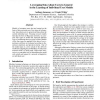600 search results - page 33 / 120 » The role of the striatum in adaptation learning: a computati... |
CVPR
2007
IEEE
14 years 9 months ago
2007
IEEE
Traditional methods for creating classifiers have two main disadvantages. Firstly, it is time consuming to acquire, or manually annotate, the training collection. Secondly, the da...
ICRA
2006
IEEE
14 years 1 months ago
2006
IEEE
— Many application tasks require the cooperation of two or more robots. Humans are good at cooperation in shared workspaces, because they anticipate and adapt to the intentions a...
IJCAI
2001
13 years 9 months ago
2001
Models of computer users that are learned on the basis of data can make use of two types of information: data about users in general and data about the current individual user. Fo...
IFIP12
2009
13 years 5 months ago
2009
Pervasive computing requires infrastructures that adapt to changes in user behaviour while minimising user interactions. Policy-based approaches have been proposed as a means of pr...
CVPR
2010
IEEE
14 years 1 months ago
2010
IEEE
We present an approach for online learning of discriminative appearance models for robust multi-target tracking in a crowded scene from a single camera. Although much progress has...


